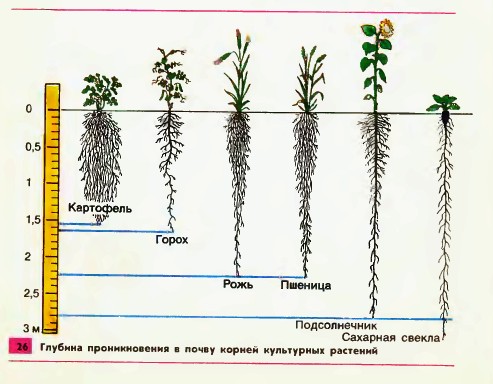The first to emerge from the seed coat is the root of the embryo. At first it is barely noticeable, but soon it stretches out and becomes large. Why is this happening?
The root of the embryo and the root of an adult plant, like all other organs, have cellular structure. The cells of the embryonic root absorb nutrient solutions from the seed, grow and divide.
If you apply transverse lines on the root of a pea sprout with ink at a distance of 2 mm from one another and place the sprout in a bottle with water poured to the bottom, after a day the distance between the marks located near the tip of the root will increase. This will happen because there is an area where young cells divide and grow. As a result of the division of these cells, new daughter cells are formed. The daughter cells in turn divide and grow. So a small root gradually turns into a big root.
The root grows from the top. It is not difficult to verify the validity of this conclusion.
If you break or cut off the tip root- its top, the growth of the root in length will stop. A root with a severed tip develops many lateral and adventitious roots. The root system becomes more powerful. Each of the lateral roots also grows at the top. This property of the root is used when transplanting seedlings of cabbage, tomatoes, asters and other cultivated plants that have a taproot system. Pinch the root while picking.
Picking- this is pinching off the tip of the root when planting young plants using a pointed peg resembling a pike.

This process got its name from the name of the peg - peaks, pickets. Picking seedlings causes the growth of lateral and adventitious roots and their proliferation in the upper, most fertile layer of soil 25 . So, in corn, the root system grows away from stem almost 2 m, and for onions - 60-70 cm.
Tree roots grow especially strongly. For example, in an adult apple tree they grow laterally at a distance of up to 15 m from the plant trunk, and to a depth of 3-4 m. The bulk of the roots develop at a depth of 15-18 cm from the soil surface. Therefore, you cannot grow vegetables, field crops or any other crops under the crowns of fruit trees.
The total length of all the roots of one plant is very large. For example, carrot roots are about 7 times longer than the above-ground part of the plant. Thanks to the growth of root systems, plants receive more nutrients from the soil. The root systems of different plants grow differently in the soil. In some they go far into the depths, in others they spread in breadth at a shallow depth 26 .
1. In what part of the root does it grow? How can this be proven?
2. What happens to the root if its top is cut off?
3. What is picking? For what purpose is it carried out?
4. How do the roots of different plants grow in the soil?
5. Why can’t you grow vegetables under the canopy of fruit trees?
>Grow some bean or pea sprouts and place them in bottles with a little water, attaching the sprouts to the caps that seal the bottles. Before this, pinch off a third of the root from half the seedlings. Watch how the undamaged and pinched roots of the seedlings grow. After a week, dry the seedlings, attach them to a sheet of thick paper and draw conclusions.
Korchagina V. A., Biology: Plants, bacteria, fungi, lichens: Textbook. for 6th grade. avg. school - 24th ed. - M.: Education, 2003. - 256 p.: ill.
Lesson content lesson notes supporting frame lesson presentation acceleration methods interactive technologies Practice tasks and exercises self-test workshops, trainings, cases, quests homework discussion questions rhetorical questions from students Illustrations audio, video clips and multimedia photographs, pictures, graphics, tables, diagrams, humor, anecdotes, jokes, comics, parables, sayings, crosswords, quotes Add-ons abstracts articles tricks for the curious cribs textbooks basic and additional dictionary of terms other Improving textbooks and lessonscorrecting errors in the textbook updating a fragment in a textbook, elements of innovation in the lesson, replacing outdated knowledge with new ones Only for teachers perfect lessons calendar plan for the year; methodological recommendations; discussion programs Integrated Lessons